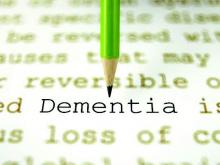SAN FRANCISCO – Among patients with mild cognitive impairment, those with extrapyramidal signs were about six times more likely to develop non-Alzheimer’s forms of dementia than those without baseline extrapyramidal signs, according to a prospective multicenter analysis.
The study is among the first to examine the link between extrapyramidal signs and dementia other than Alzheimer’s disease, said Woojae Myung, MD, of Sungkyunkwan University School of Medicine in Seoul, South Korea, and his associates. “Our results suggest that careful assessment of extrapyramidal signs in patients with incident mild cognitive impairment (MCI) can yield important clinical information for prognosis,” the researchers wrote in a poster presented at the 2016 congress of the International Psychogeriatric Association.
The study included 882 adults who were enrolled in the Clinical Research Center for Dementia of Korea (CREDOS) registry between 2006 and 2012. All participants met criteria for mild cognitive impairment based on the Korean version of the Mini-Mental State Examination (K-MMSE) and also underwent standardized neurologic examinations, magnetic resonance imaging, and the 15-item Geriatric Depression Scale (GDS-15) at baseline, Dr. Myung and his coinvestigators reported.
In all, 234 patients (26%) converted to dementia over a median follow-up time of 1.44 years (interquartile range, 1.02-2.24 years). Most (92%, or 216) patients who developed dementia had probable Alzheimer’s disease, while 9 had vascular dementia, 4 had Lewy body dementia, 3 had frontotemporal dementia, 1 had progressive supranuclear palsy, and 1 had dementia associated with normal pressure hydrocephalus.
Baseline extrapyramidal signs were the only significant factor associated with progression to non-Alzheimer’s forms of dementia (hazard ratio, 6.33; 95% confidence interval, 2.30-13.39; P less than .001) after controlling for age, gender, educational level, diabetes, hypertension, MRI evidence of matter hyperintensity, GDS-15 score, and level of cognitive impairment at baseline, the researchers reported. Furthermore, patients with baseline extrapyramidal signs were about 30% less likely to develop Alzheimer’s disease than were patients who did not have extrapyramidal signs at baseline.
Significant predictors of Alzheimer’s disease included older age, higher educational level, absence of hypertension, and a lower K-MMSE score, as well as the presence of amnestic mild cognitive impairment, the investigators noted.
They disclosed no funding sources or conflicts of interest.

